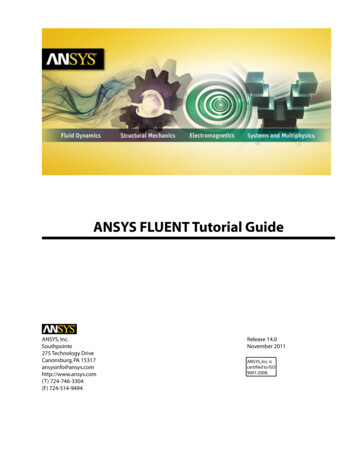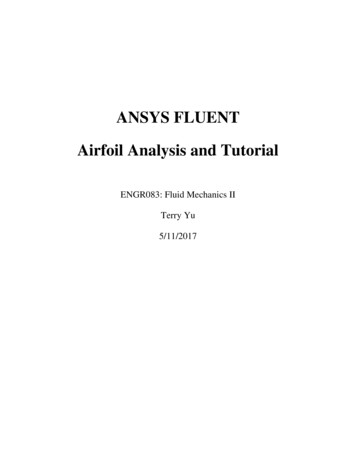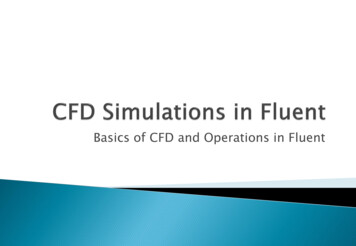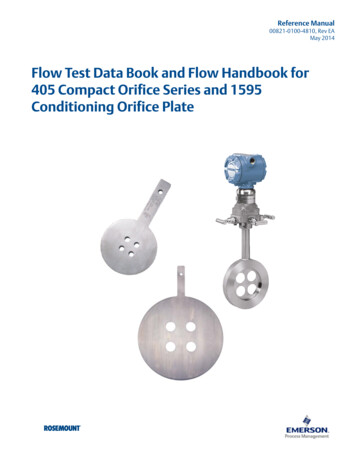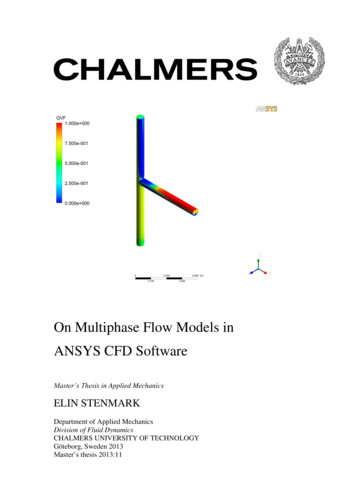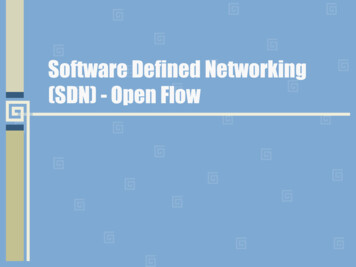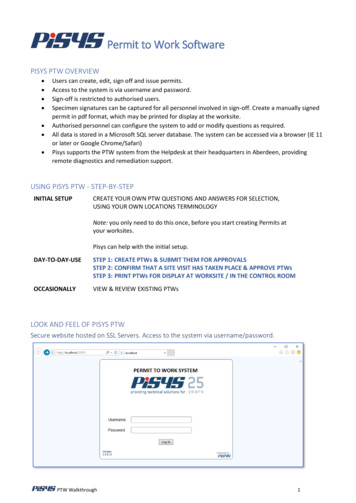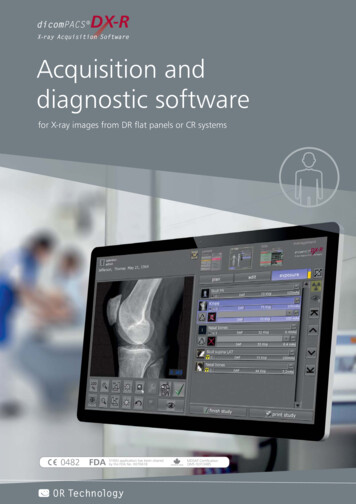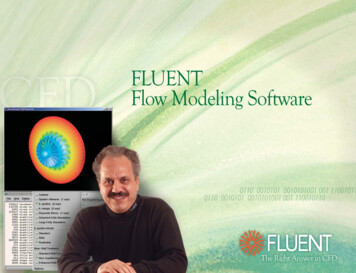
Transcription
FLUENTFlow Modeling Software
On the cover: Dimitrios Tselepidakis,Customer Services Team Leader,Electronics & Semiconductors, FluentSimulation on cover: staticpressure on an Eckardt Rotor ORight: vortex structures generatedby aircraft landing gear
The Right Answer in CFDWhen people think of CFD, the name FLUENT comes to mind. The broad physicalmodeling capabilities of FLUENT have been applied to industrial applications rangingfrom air flow over an aircraft wing to combustion in a furnace, from bubble columnsto glass production, from blood flow to semiconductor manufacturing, from clean roomdesign to wastewater treatment plants. The ability of the software to model in-cylinderengines, aeroacoustics, turbomachinery, and multiphase systems has served to broadenits reach. Today, thousands of companies throughout the world benefit from thisimportant engineering design and analysis tool. Its extensive range of multiphysicscapabilities make it the most comprehensive software available to the CFD community.With its long-standing reputation of being user-friendly and robust, FLUENT makesit easy for new users to come up to productive speed. Most importantly, technicalsupport is top-notch, from the initial training to the ongoing relationship that developsbetween customers and Fluent staff. Throughout the years, these importantcomponents—comprehensive models, usability, and personalized technicalsupport—have combined to make FLUENT the CFD software of choice acrossa broad spectrum of industries worldwide.Friction on a female elite swimmerPressure field near the Wright FlyerA motorcycle in cornering positionCourtesy Speedo International Ltd.Postprocessing by Advantage CFD usingEnSight by CEICourtesy of Advantage CFD, www.advantage-cfd.co.uk“Fluent’s CFD software has given us the ability to quickly predict the behavior of several designproposals that previously could not be modeled. We are also able to reduce our test time and expenseby eliminating designs that do not perform as intended.”Raymond H. Horstman,Environmental Control Systems,Boeing Commercial Airplane Group
Grids, Numerics, Parallel ProcessingAt the core of any CFD calculation is a computational grid, used to divide the solutiondomain into thousands or millions of elements where the problem variables arecomputed and stored. In FLUENT, unstructured grid technology is used, which meansthat the grid can consist of elements in a variety of shapes: quadrilaterals and trianglesfor 2D simulations, and hexahedra, tetrahedra, prisms, and pyramids for 3D simulations.These elements, created using automated controls in GAMBIT, FLUENT’s companionpreprocessor, form an interlocking network throughout the volume where the fluid flowanalysis takes place.HexCore meshParallel scalability for two FLUENT test casesIn the commercial CFD market today, no other provider offers more complex physicalmodels on an unstructured grid than FLUENT. Sophisticated numerics and a robustsolver ensure accurate results. The new non-iterative time advancement scheme hasgreatly reduced the time-to-solution for transient simulations. Mature parallelprocessing capabilities, available on NT, Linux, and Unix platforms, can be used onmultiple processors of a single machine or multiple machines on a network. Dynamicload balancing automatically detects and analyzes parallel performance and adjusts thedistribution of computational cells among the processors so that a balanced load isshared by the CPUs.Quad pavingTetrahedral mesh“Using Fluent’s preprocessing software, we made light work of our client’s complex building geometry in a 2 millioncell simulation. Solving this CFD model on an NT Cluster allowed us to predict the effects of solar radiation onoccupant comfort. Using FLUENT, we have been able to concentrate more on analyzing results than ever before.”Matthew Kitson,Environmental Modeling,Hilson Moran Partnership Ltd.Sung-Eun Kim,Principal Development Engineer, Fluent
Turbulence and AcousticsAeroacoustics is an important focus for many industrial applications, but has traditionallybeen difficult to simulate. In FLUENT, the noise resulting from unsteady pressurefluctuations can now be computed in several ways. Transient LES predictions forsurface pressure can be converted to a frequency spectrum using the built-in FastFourier Transform (FFT) tool. The Ffowcs-Williams & Hawkings acoustics analogy canbe used to model the propagation of acoustic sources for objects ranging from exposedbluff bodies to rotating fan blades. Broadband noise source models allow acousticsources to be estimated based on the results of steady-statesimulations, so are practical tools for quickly evaluatingdesign modifications.FLUENT has always defined the cutting edge of turbulence modeling in commercialCFD software, offering an unparalleled breadth of models. Several versions of theheavily used and time-honored k-ε model are available, as is the Reynolds stressmodel (RSM) for highly swirling or anisotropic flows. Recent increases in computerpower, coupled with decreases in cost, have combined to make large eddy simulation(LES) and the more economical detached eddy simulation (DES) turbulence modelsvery attractive for industrial applications. Other models round out the offerings so thatany flow condition can be simulated. Wall functions and enhanced wall treatmentoptions allow for the best possible representation of all wall-bounded flows.Vortex shedding predicted by the LES modelTransient wake behind a truck predicted using DESAcoustic power level on the surface of a sedanTrajectories of particle phases in a cyclone using RSMCourtesy of International Truck & Engine Corp.“The physical models and CFD solutions implemented in FLUENT are versatile, accurate andparticularly strong for chemical process applications. In addition, FLUENT allows us to modelcomplex geometries easily which saves significant turnaround time.”Hiroaki Takehara,Science and Technology Research Center,Mitsubishi Chemical Corporation
Dynamic and Moving MeshInternal combustion engines, valves, store separation, and rocket launches areexamples of problems where moving parts define the fluid flow. In FLUENT, thedynamic mesh capability meets the needs of these challenging applications. It hasseveral different mesh rebuilding schemes, which can be used for different movingparts within the same simulation, as needed. Only the initial mesh and a descriptionof the boundary movement are required. Dynamic meshing is compatible with ahost of other models, including FLUENT’s suite of spray breakup and combustionmodels, multiphase flow, free surface prediction, and compressible flow.Internal combustion engineThe periodic motion inside mixing tanks, pumps, and turbomachinery has traditionallybeen simulated with moving mesh models in FLUENT. The sliding mesh and multiplereference frames models have a proven track record and are fully compatible withother relevant models, such as LES, reacting, and multiphase flow.Water surface disturbed by a spinning gear wheelBackground photo courtesy of Deutz AGIn-Cylinder . Store Separation . Passing Vehicles . ValvesPumps . Turbomachinery . Mixing TanksDisruption of air flow resulting from flapping wing flight
Heat Transfer, Phase Change, RadiationOther capabilities closely associated with heat transfer include models for cavitation,compressible liquids, heat exchangers, shell conduction, real gas, and wet steam.The phase change model tracks melting and freezing in the bulk fluid. Evaporationfrom droplets or wet particles and devolatilization from coal are available with thediscrete phase model (DPM). The straightforward addition of heat sources and acomplete set of thermal boundary condition options round out the capabilities,making heat transfer modeling in FLUENT a mature and reliable tool to meet anyset of needs.Heat transfer accompanies many fluid flow phenomena and FLUENT offers acomprehensive suite of options for convection, conduction, and radiation. Forradiation, the P1 and Rosseland models are available for environments withoptically thick (participating) media, and a view-factor-based surface-to-surfacemodel is available for environments with non-participating media. The discreteordinates (DO) model is suited for any medium, including glass. A general-purposediscrete ray tracing model (DTRM) is also available. A solar load model makesuse of a ray-tracing algorithm and includes a solar calculator. It allows forvisualization of illuminated and shadowed areas, making climate controlsimulation results meaningful.Air density after a gun blastCourtesy of Benet LaboratoriesUranium melt and solidification in a failed reactorRadiation heat transfer at a raclette partyCourtesy of TRACE/NASA Small Explorer ProgramHeat Exchangers . Compressible Flow . MeltingFreezing . Evaporation . BoilingNicole Diana,FLUENT Product Manager, Fluent
Reacting FlowChemical reaction modeling, especially in turbulent conditions, has been a hallmarkof FLUENT software since its inception. Over the years, the comprehensive reactionmodeling capabilities in FLUENT have helped engineers meet the diverse challengesof difficult combustion processes. The eddy dissipation concept, PDF transport, andstiff finite rate chemistry models have recently joined FLUENT’s proven workhorses:the eddy dissipation, equilibrium mixture fraction, flamelet, and premixed combustionmodels for tackling a vast array of gaseous, coal, and liquid fuel combustion simulations.Models for the prediction of NOx formation are also widely used and customizable.Temperatures on a flame surfaceCourtesy of Astec IndustriesEric Bish,FLUENT Product Support Manager, FluentMany industrial applications involve reactions that take place on solid surfaces.FLUENT’s surface reaction capability allows for reactions between gas and surfacespecies as well as between different surface species, so that deposition and etchingcan be rigorously predicted. Simulations of catalytic converters, gas reformers,pollution control devices, and semiconductor manufacturing have all benefited fromthis technology.FLUENT’s reaction models can be used in conjunction with the LES and DES turbulencemodels. When these transient turbulence models are coupled with the reacting flowmodels, the power to predict flame stabilization and burnout becomes possible.Tri-fuel pre-mix burnerTemperatures in selective catalytic reduction ductworkCourtesy of Astec IndustriesCourtesy of Babcock PowerGas Turbines . Boilers . Furnaces . Chemical Vapor DepositionErosion . Emissions . Flares . Etching . Catalytic Converters
MultiphaseMultiphase mixtures are widespread in industrial applications, and FLUENT is a leader inmultiphase modeling technology. Its varied capabilities allow engineers to gain insight intoequipment that is often difficult to probe. The Eulerian multiphase model makes use ofseparate sets of fluid equations for interpenetrating fluids or phases. Special physics areavailable if one of the fluids is granular. In many cases, the more economical mixturemodel can be used for granular and non-granular mixtures as well. Three-phase mixtures(liquid, granular, and gas) can be modeled, so simulations of slurry bubble columns andtrickle bed reactors are possible. Heat and mass transfer between phases can take place,making homogeneous and heterogeneous reactions possible.Cavitation in an automotive fuel pumpSeveral other multiphase models are also standard in FLUENT. For some multiphaseapplications, such as spray dryers, coal furnaces, and liquid fuel sprays, the discretephase model (DPM) can be used. Injections of particles, bubbles, or droplets canundergo heat, mass, and momentum transfer with the background fluid.The volume of fluid model is available for free surface flows, such as oceanwaves, where the prediction of the interface is of interest. The cavitationmodel has proven useful for modeling hydrofoils, pumps, and fuel injectors.Boiling can be implemented though readily available user-defined functions.Bubbles in a fluidized bedBreaking ocean waves on an oil platformCopyright photo by Brooks Martner, NOAA/ETLBubble Columns . Fluidized Beds . Risers . Water Waves . Tank Sloshing . SeparatorsSpray Breakup . Cavitation . Boiling . Coal Burners . Spray Dryers
Pre- and PostprocessingFluent offers software for the creation of problem geometries and grids. GAMBITallows users to build geometries using basic construction tools. Alternatively, it canbe used to read CAD files and condition the imported geometry for CFD analysis.For fast, flexible meshing, Fluent offers GAMBIT as well as TGrid, a state-of-the-artvolume mesher. Both tools have many automated features for building or joininghybrid meshes with attention to boundary layers, nonuniform sizing, and core regionsof hexahedral cells. For turbomachinery applications, G/Turbo is available. Thispreprocessing tool uses familiar terminology and parametric templates to assistin problem setup.Flow around an Opel AstraSolids suspension in a stirred tankFLUENT’s postprocessing tools can be used to generate meaningful graphics,animations, and reports that make it easy to convey CFD results to engineers andnon-engineers alike. Shaded and transparent surfaces, pathlines, and sceneconstruction are just some of the postprocessing features that make FLUENTgraphics unique. Solution data can be exported to third party graphics packages,or can be exported to CAE packages for additional analysis.Turbulent kinetic energy in a steel tundishCourtesy of Adam Opel AG“For a technology-based company like Norsk Hydro, CFD analysis using FLUENT has become an essential and accepted tool for problem analysis and optimization.FLUENT is used in all kinds of studies, from ventilation simulations via mixing analysis to complex multiphase separator calculations. We have come to appreciate thevariety of models and the flexibility of the code. For us, FLUENT has proven to bring added value to the modeling proc
Fluent offers software for the creation of problem geometries and grids. GAMBIT allows users to build geometries using basic construction tools. Alternatively, it can be used to read CAD files and condition the imported geometry for CFD analysis. For fast, flexible meshing, Fluent offers GAMBIT as well as TGrid, a state-of-the-art volume mesher. Both tools have many automated features for building or joining
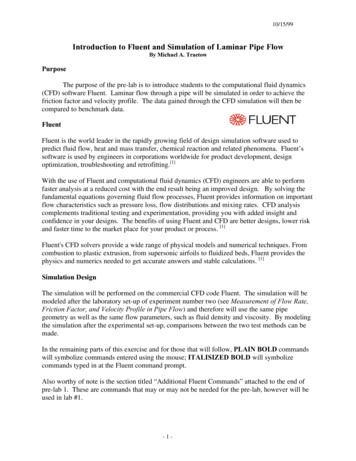
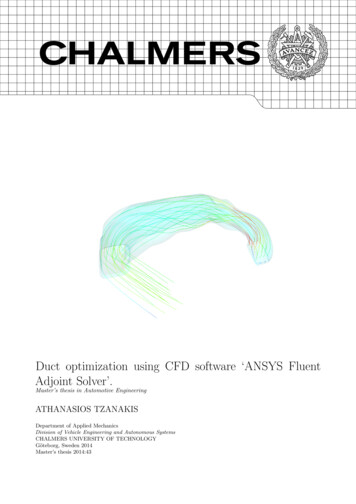
![Fluent Python : [clear, concise, and effective programming]](/img/1/799981060.jpg)
